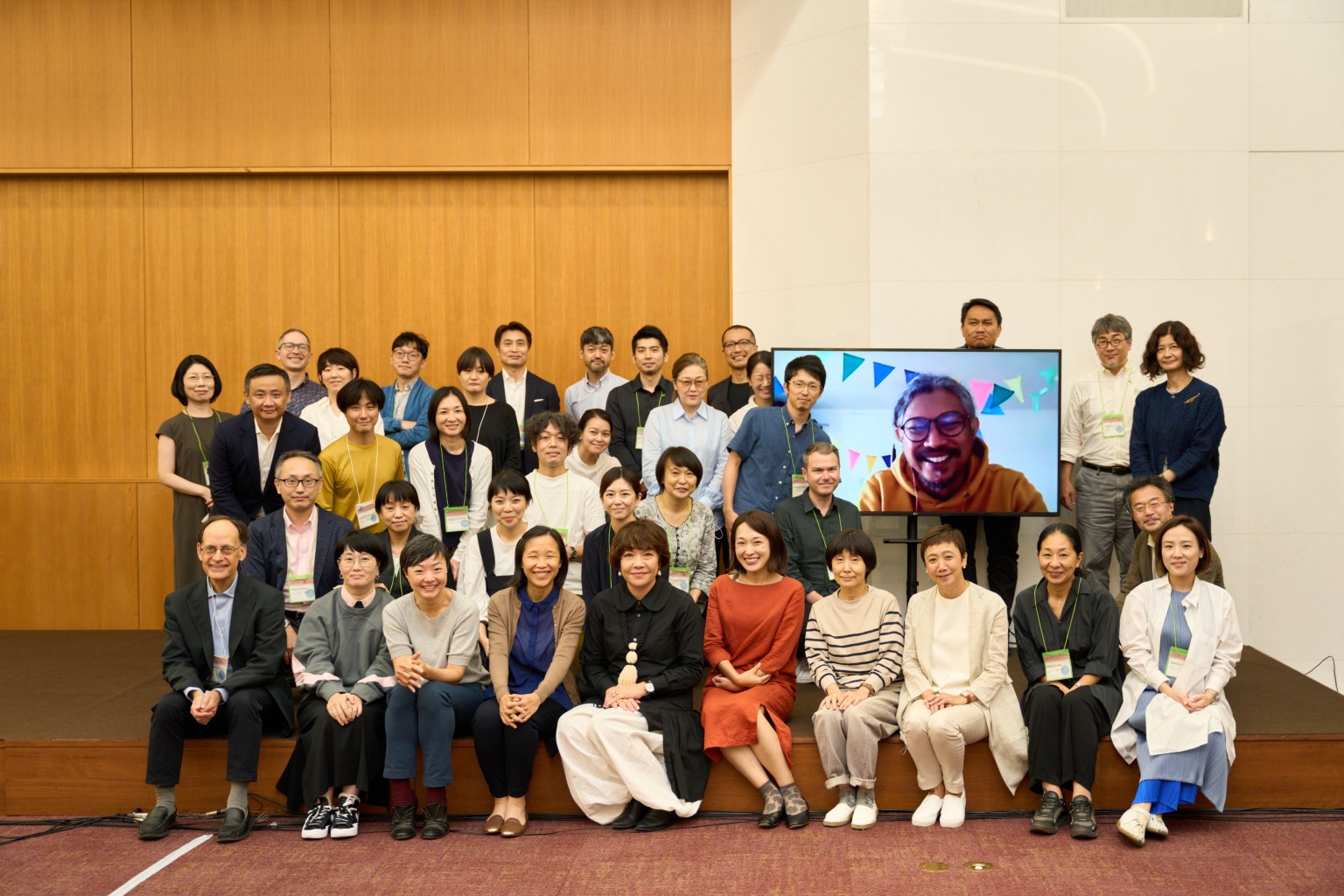Art writer and editor. She also works as an art coordinator in many exhibitions and projects. The editorial staff of RealTokyo.
Session 3: Overseas Exhibitions and Discourses of Modern and Contemporary Japanese Art
Moderator: Kenji Kajiya (Professor, The University of Tokyo)
Presenters:
Bert Winther-Tamaki (Professor, University of California, Irvine)
Gabriel Ritter (Director of the Art, Design & Architecture Museum and Associate Professor, University of California, Santa Barbara)
Chelsea Foxwell (Associate Professor of Art History, East Asian Languages and Civilizations, University of Chicago)
On the second day of the workshop, Session 3 focused on past exhibitions of modern and contemporary Japanese art held overseas, especially in the United States. Given that the Bunka-cho Art Platform Japan project has been translating key texts relating to modern and contemporary Japanese art, the session sought to conduct a historical examination of how exhibitions and discourses of modern and contemporary Japanese art have been disseminated and received outside Japan.
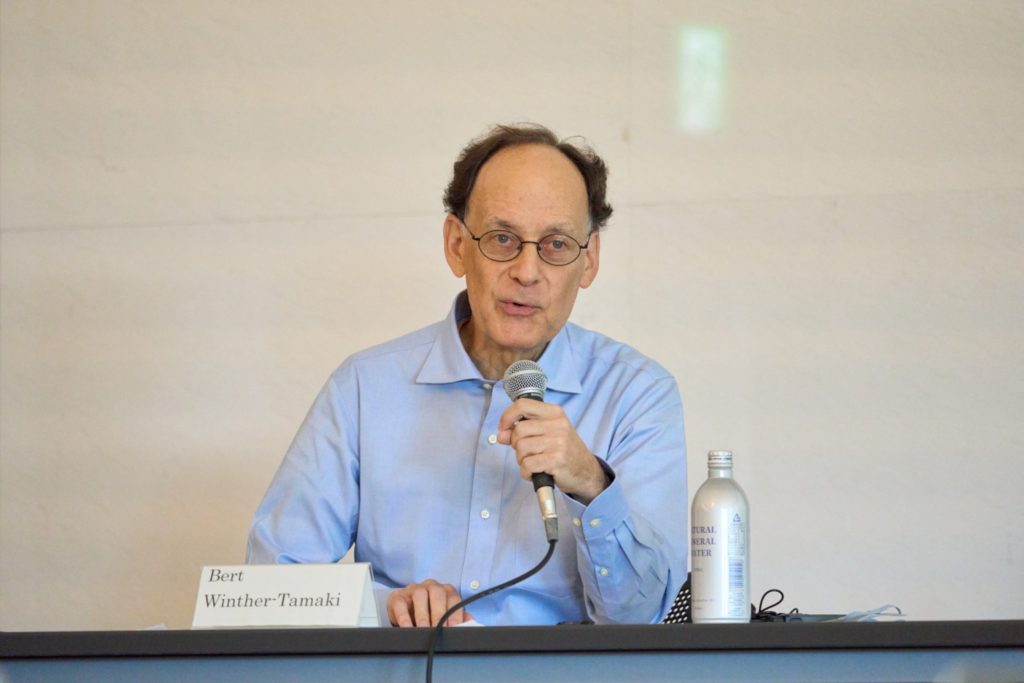
“Responses to Exhibitions of Contemporary Japanese Art in the US, 1986‒94”
Bert Winther-Tamaki (Professor, University of California, Irvine)
Winther-Tamaki compared four exhibitions of contemporary Japanese art held in the United States between 1986 and 1994: “Tokyo: Form and Spirit,” “Against Nature,” “A Primal Spirit,” and “Scream Against the Sky.” He explained that a key motivation driving these exhibitions was American fascination and wariness regarding Japan’s rapid postwar economic growth and affluence in the period of the economic bubble. On the Japanese side, there was a desire to elevate the prevailing American image of Japanese culture and promote understanding.
“Tokyo: Form and Spirit,” held in 1986 at the Walker Art Center in Minneapolis, was funded by Japanese and U.S. institutions both public and private, which were seeking to attract Japanese companies to invest in the American Midwest. Japanese architects and designers composed seven installations featuring graphic design, architecture, and performance, representing life in the capital city of Tokyo. The imaginative interpretations of topics such as “technology and humanity” and “aesthetics in labor” presented in these installations were well received, but the exhibition did not attempt to explicate the historical development of Japanese culture.
“Against Nature: Japanese Art in the Eighties” started out at the San Francisco Museum of Modern Art in 1989 before traveling to seven other U.S. cities as well as ICA Nagoya. This challenging polemical exhibition of contemporary art, curated by Kathy Halbreich, Thomas Sokolowsky, Kohmoto Shinji and Nanjo Fumio, celebrated kitschy hybrid forms and linked them to postmodern thought in opposition to the stereotype image of Japanese culture as coexisting harmoniously with nature and tradition. It featured works by artists such as Morimura Yasumasa, Miyajima Tatsuo, and Ohtake Shinro. Critics characterized the exhibition as “presenting a mirror image of the West’s own culture” while reflecting the effects of Japan’s consumerism and technology-driven society, the result of rapid economic growth after World War II under the influence of Western culture.
In contrast, “A Primal Spirit: Ten Contemporary Japanese Sculptures,” held nearly simultaneously with “Against Nature,” introduced ten Japanese artists working with wood and other natural materials. The premise of the exhibition—a spirit of sculpture rooted in the ancient Japanese religious views of nature—was sharply rejected by some, including Kawamata Tadashi, one of the participating artists. The arguments of “Against Nature” and “A Primal Spirit” were at odds with each other, but these views subsequently came to be seen as an ongoing polarity threaded throughout of contemporary Japanese art.
“Japanese Art After 1945: Scream Against the Sky” of 1994 represented a new benchmark in the history of exhibitions of Japanese contemporary art in the United States. Previously, such exhibitions had been organized by curators who were well versed in modern and contemporary art but newcomers to Japan. In contrast, “Scream Against the Sky” was curated by Alexandra Munroe, who brought considerable expertise in Japanese studies to the task of building a comprehensive narrative of modern Japanese art history. Winther-Tamaki concluded by noting that while doubts about whether art could meaningfully represent a nation were threaded throughout each of these exhibition projects, for the most part, such doubts were overridden and art was deployed and received as bearing deep truths about Japanese identity.
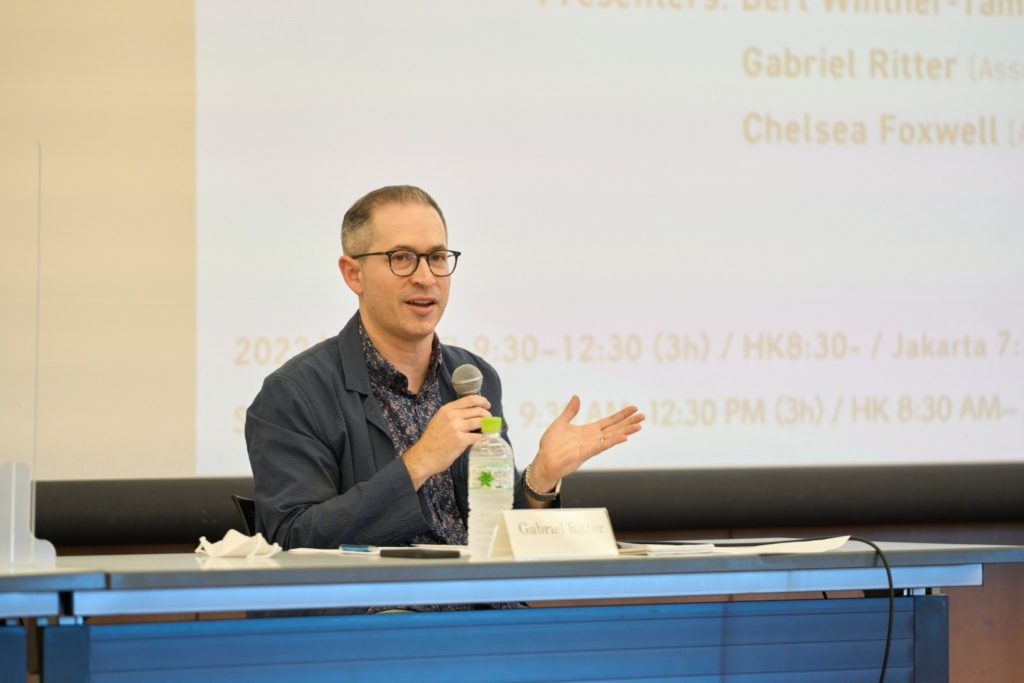
“From The Door into Summer to Winter Garden: The Global Reception of Japan’s Micropop Generation”
Gabriel Ritter (Director of the Art, Design & Architecture Museum and Associate Professor, University of California, Santa Barbara)
Gabriel Ritter’s presentation focused on two exhibitions curated by the art critic Matsui Midori: “The Door into Summer” and “Winter Garden.”
“The Door into Summer: The Age of Micropop” was an exhibition held in 2007 at the Art Tower Mito Contemporary Art Gallery in Mito, Ibaraki, and curated around the concept of Micropop. A term conceived by Matsui, it refers broadly to “the creativity of those who have a ‘minor’ relationship to major culture. Forced to operate within a frequently oppressive dominant culture, and equipped with insufficient means, such individuals compensate for their relative social obscurity and economic disadvantages with the free play of imagination, making do with whatever is at hand.” With Murakami Takashi’s “Superflat” exhibition having made headlines during its tour of the U.S. and Europe between 2001 and 2007, Matsui positioned Micropop artists in opposition to the otaku-inspired works of Murakami, Yanobe Kenji, and Aida Makoto, emphasizing the Micropop Generation’s use of a “childlike” imagination to unlock the unrealized potential and latent beauty in banal, everyday materials and situations.
Most of the 15 artists featured in “The Door into Summer” were born after 1965—the generation that had experienced events such as the 1995 Kobe earthquake and the Aum Shinrikyo terrorist attacks of the same year. Ritter noted that he appreciates the significance of Matsui’s perspective, which finds a micropolitical attitude toward the real world in the personal practices of Micropop artists.
“The Door into Summer” ended as a single-site exhibition, but the Micropop concept was developed further two years later into “Winter Garden: The Exploration of the Micropop Imagination in Contemporary Japanese Art,” an exhibition held under the auspices of the Japan Foundation. Although “Winter Garden” traveled to 44 locations around the world over a 10-year period, it was exhibited in small and medium-sized spaces and rarely received the sort of coverage enjoyed by “Superflat.” However, Ritter concluded that “Winter Garden,” which toured the world steadily for a decade, certainly contributed to promoting understanding of Japanese art in the 2000s, citing the sense of intimacy created by the exhibition’s comparatively small scale and its appeal to audience segments such as students and artists with few opportunities to familiarize themselves with contemporary forms of expression from overseas.
Quoted from: Midori Matsui “Micropop Manifrsto: What Is Micropop?” from the catalogue of Age of Micropop: The New Generations of Japanese Artists (Published by Parco Co., Ltd.)
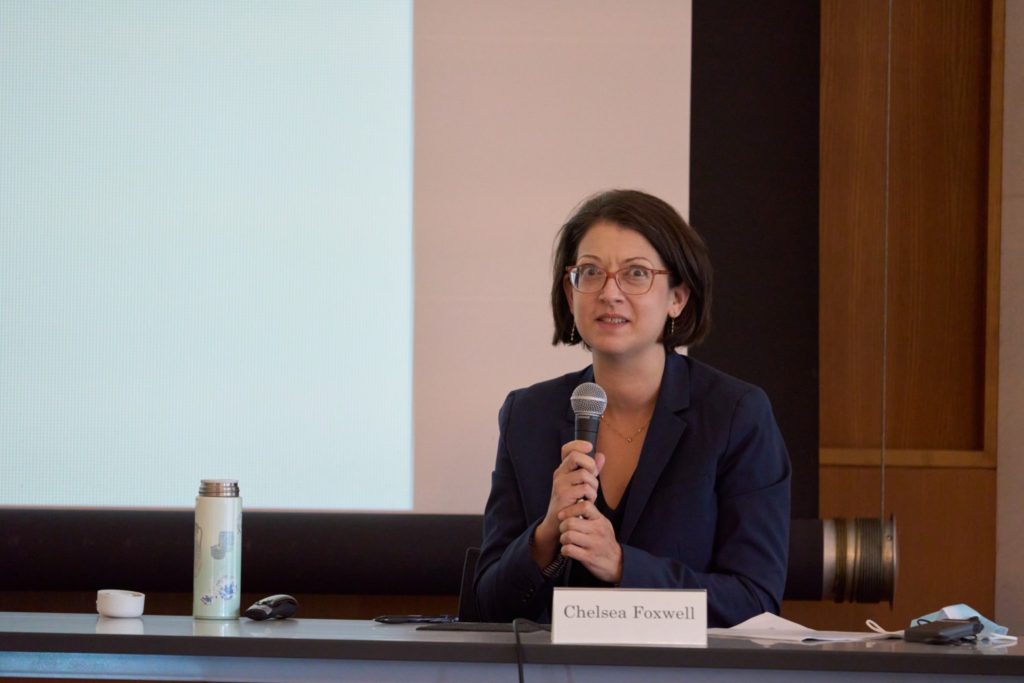
“Recent Trends in U.S. Museum Exhibitions of Postwar and Contemporary Japanese Art: With an Eye to Fostering Growth and Diversity”
Chelsea Foxwell (Associate Professor of Art History, East Asian Languages and Civilizations, University of Chicago)
For the American public, contemporary Japanese art is synonymous with Murakami Takashi and the popular art that emulates his style. To illustrate how this view arose, Foxwell presented the results of a study of postwar Japanese contemporary art exhibitions in the U.S. from 2011 to 2022 and the structural causes that emerge from those results.
While recognizing the limitations of making distinctions by material, Foxwell noted that the most common genres of exhibition were ceramics and crafts, prints, and photography/video. In her analysis, this can be attributed to the structure of museums, with their dedicated exhibition spaces and staffs of specialists who share genre-specific languages and histories. Interviews with curators also revealed that budget and time constraints prevented them from conducting research across genres and regions. However, some U.S. museums, which have generally sought specialists of Western art as curators of modern and contemporary art, have recently made a conscious effort to form transregional networks by hiring curators from non-Western regions and with different areas of expertise. Commenting on the study, Foxwell said that viewing current market trends and tendencies in exhibitions about Japan in the U.S. as the result of audience or curatorial preferences would be a mistake, and that it is necessary to consider their concentration from a structural perspective. She also argued that in order for a wider range of works to be exhibited, what is needed is an ecosystem-focused approach involving not only curators and museums, but parties such as dealers and collectors as well.
Foxwell concluded by pointing out historical legacies of bias and Orientalism in the U.S. museum system and collections, and introduced recent research in art history that seeks to change the once Western-centric field from the perspective of time. Employing art historian Tomii Reiko’s term “contemporaneity,” she touched on the rich contemporary possibilities that eschew the center-periphery dichotomy. “Museums are research institutions that shape the present and future of contemporary art. I hope we can work together to build a creative and healthy ecosystem,” she said.
Discussion
The Bunka-cho Art Platform Japan project aims to further the sustained development of contemporary Japanese art and to raise its international profile. But what does contemporary Japanese art mean in this context, and how can it be supported? In the discussion that followed, these questions presented by Kajiya led to an exchange of opinions on the relativization of “Japaneseness” and the nature of exhibitions based on art from a specific country.
Winther-Tamaki noted that in the 1980s, “Japan was very powerful economically, and Japanese cultural nationalism was perceived as a threat. However, in today’s multipolar, post-global world, it has come to be seen as sympathetic rather than threatening.” He also called for further examination of history, along with debate that incorporates a wide range of perspectives.
Foxwell, who gave an interesting presentation on genres and numbers of exhibitions, touched on the changing museum environment. “Museums are in a state of flux, with some now treating artworks flexibly as forms of contemporary expression rather than in the context of genres, with works from different genres often exhibited in the same space,” she said. “Artists now work across national borders, and the perspective has shifted to viewing works through the artist’s personal and cultural background.”
Given the prominence of crafts and photography in Foxwell’s statistics, Winther-Tamaki asked her about the influence of the Western genre hierarchy, which places painting and sculpture at the top. In response, Foxwell noted that there may be practical reasons at play, given the fact that “ceramics are easy to store and relatively accessible from a financial standpoint.” Ritter added, “You can buy dozens of bamboo works and ceramics for the price of one Yayoi Kusama piece, so there’s the advantage of easily being able to add [such works] to a collection.”
In response to the question of how museums classify items that could fall into multiple categories, Ritter noted that this “often depends on the curator who acquired the item in question,” adding that “U.S. museums are beginning to review their country-specific collections, but at the same time, there is criticism of such universalization. Given the concern that the cultural specificity of a particular work could be lost, it is important to cultivate an environment and stance that allows for global and open conversation, rather than relying only on a centralized approach.”
Through the three lucid presentations that constructed careful arguments while citing numerous forms of evidence, it became clear that there is no single way of looking at history, and that art history changes with the times. It will be interesting to see how history will in time evaluate these new transnational museum initiatives and revisions of art history, including those presented during the session.
Session 4:Case Studies for Generating International Dialogue
Moderator: Yukie Kamiya (Art critic, curator)
Presenters:
Ade Darmawan (Founding member and spokesman of ruangrupa / Artistic director of documenta 15)
Nakamura Fumiko (Curator, Aichi Prefectural Museum of Art / Aichi Triennale 2022)
Che Kyongfa (Curator, Museum of Contemporary Art Tokyo)
Carol Yinghua Lu (Art historian and curator / Artistic director of the Yokohama Triennale 2023 / Director, Inside-Out Art Museum, Beijing)
Session 4 brought together directors and curators of current festivals, contemporary art museums, and an upcoming triennial to discuss the challenges of programming that generates international dialogue.
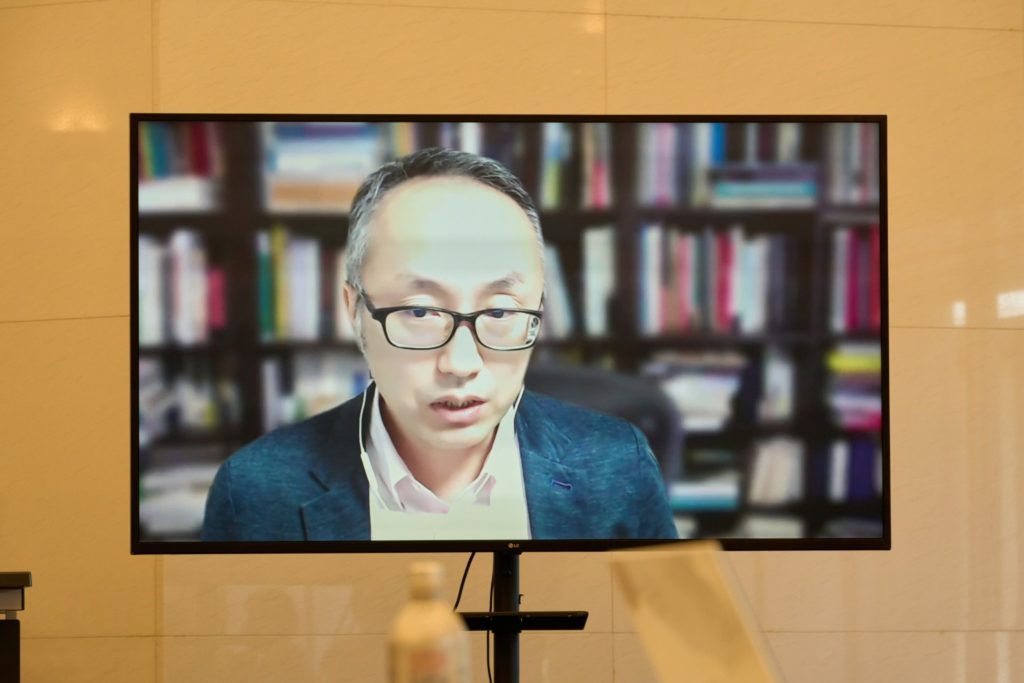
“Lumbung: Documenta 15—space as a living room for citizens”
Ade Darmawan (Founding member and spokesman of ruangrupa / Artistic Director of documenta 15)
Ade Darmawan, Artistic Director of documenta 15 and a founding member of the Indonesian artist collective ruangrupa, took part in the workshop remotely. ruangrupa is a collective formed by artists in 2000 that experiments in and practices sustainable ways for artists and art practitioners to persist in local communities.
Darmawan began with an explanation of lumbung, which are Indonesian communal rice barns. After rice is harvested, the people of the community take what they need, while the remainder is stored in the lumbung, which is operated independently by the community as a whole. In 2018, ruangrupa worked with other collectives to launch an ecosystem called Gudskul, with the lumbung being at the center of this mechanism. Gudskul brings together all of the collectives’ resources, including knowledge, skills, and funds, and co-pools and distributes them proportionally according to each collective’s needs. The concept of lumbung was also utilized for Documenta 15, being put into practice in various aspects of the exhibition and its management.
Departing from the traditional method of a curator deciding on a theme and commissioning artists to create works, this approach involved what Darmawan called a “relationship of mutual commitment” in which no specific theme was established in advance, and display locations and content were decided in the course of dialogue involving the various collectives and artists taking part. The budget was made up of seed money allocated equally for production costs and a collective pot for mutual support. The exhibition site was regarded as a space open to the local community, and the artists stayed there to share their experiences with residents in a grassroots way as part of their daily lives. Some 1,200 activities took place over the festival’s 100 days, including free schools, class, performances, exhibitions, music, a cinema caravan, market, cooking, talks, and karaoke.
The experimental Documenta 15, which in the form of an international exhibition demonstrated how a collective functions through independence, transparency, and solidarity, “was more an invitation to travel with us than an exhibition,” Darmawan said.
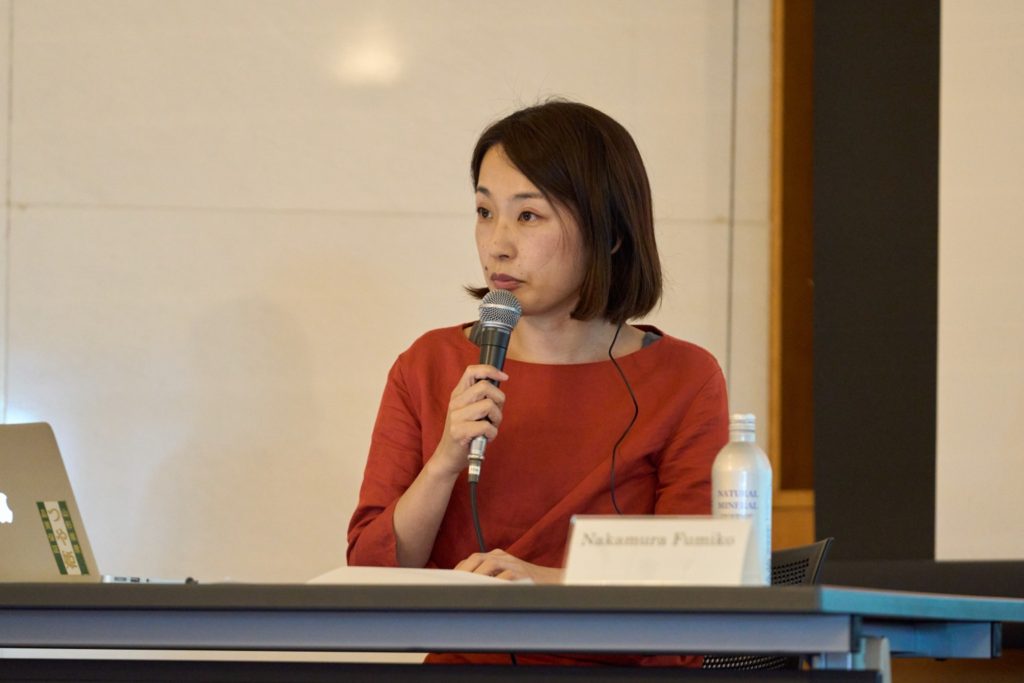
“With whom are we in dialogue?: In the case of Aichi Triennale”
Nakamura Fumiko (Curator, Aichi Prefectural Museum of Art / Aichi Triennale 2022)
Held for the first time in 2010, the Aichi Triennale initially grew out of the legacy of the 2005 Aichi World Expo. Nakamura discussed the practices of the event’s 2022 edition, which aimed to break away from the old model of a showcase of nation-states inherited from the world’s fairs of the 19th century, creating instead a 21st-century international exhibition that facilitates international dialogue from a local standpoint.
Aichi Triennale 2022 encompassed contemporary art, performing arts, and learning, with 100 artists from 32 countries and regions participating. The program was curated jointly by Japanese curators and curatorial advisors from both Japan and overseas. Nakamura noted that this arrangement allowed for the introduction of a wider geographical range of artists and works than ever before, despite the influence of the pandemic. The theme “Still Alive” was taken from the title of an artwork by world-renowned conceptual artist and Aichi native Kawara On.
Aichi Triennale has strong local roots, with 60 percent of the festival’s audience being residents of Aichi Prefecture. The event spanned four locations: the Aichi Arts Center in the city of Nagoya, the cities of Ichinomiya, Tokoname, and the Arimatsu district in Nagoya City. With 60 percent of the exhibited artworks being new, Nakamura said that in order to create works that do not rely solely on regional characteristics but have international significance, it is important to undertake a critical reading of the industry, history, and culture of the region in question, and to connect and relocate local phenomena into a transnational context. This provides local residents with an opportunity to learn new things about their community. Additionally, the festival reached out to the many foreign residents in Aichi Prefecture, trialing guided tours in languages other than Japanese and English.
Nakamura argued that art festivals have the power to dismantle the global-local dichotomy, and that clues to international dialogue may be found in the dynamism of how local events and global trends circulate and flow between specialists and local residents.
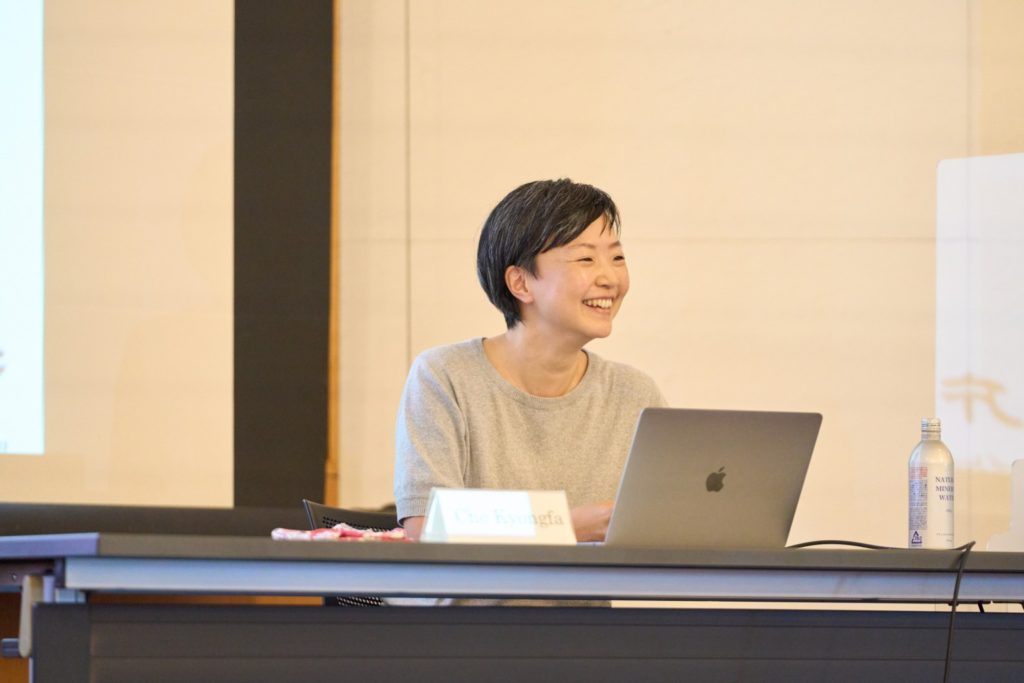
“Expanding Here and Now”
Che Kyongfa (Curator, Museum of Contemporary Art Tokyo)
Che Kyongfa, curator of the Museum of Contemporary Art Tokyo (MOT), presented three collaborative projects in which she has been involved in her capacity as museum curator. First, as a case of collaboration with fellow curators from the Asia-Pacific region, she introduced the “Time of Others” exhibition, which was held from 2015 to 2016. The exhibition was co-produced by, and traveled to, the MOT, the Japan Foundation Asia Center, the National Museum of Art, Osaka, the Singapore Art Museum, and the Queensland Art Gallery | Gallery of Modern Art.
Between 2015 and 2020, when the MOT was undergoing renovation, Che undertook a five-year collaboration with KADIST, a Parisian non-profit cultural organization. Together with Elodie Royer, she presented the exhibitions “Almost nothing, yet not nothing,” held in 2017 at the Tokyo University of the Arts’ Arts & Science Lab (as part of the MOT Satellite project), “Les nucléaires et les choses,” a solo exhibition by Fujii Hikaru held at KADIST in Paris in 2019, and “Things Entangling” at the MOT in 2020.
In addition, Che introduced a collaborative project she is currently working on together with the Dutch artist Wendelien van Oldenborgh, presenting their process of research and dialogue through which Van Oldenborgh is creating new works in Japan, set to be exhibited at the MOT at a future date.
According to Che, all three of her collaborations were guided by the question of how contemporary art can share present-day questions with audiences and enable thinking beyond national frameworks. The “Time of Others” exhibition was an attempt to re-question the otherness and differences that are (re)produced in the contemporariness and fragmentation brought about by geopolitical changes in the Asia-Pacific region, while “Things Entangling” researched and exhibited the works of artists who attempt social criticism by focusing on the discourse and history of various things. And with Van Oldenborgh, the starting point was to examine the connections and distance between the social and historical contexts of the Netherlands, the artist’s native country, and Japan.
According to Che, in such collaboration it is important to correctly identify the practices and interests of the curators and artists involved, and to build relationships of equal and open dialogue based on this understanding. However, she also pointed out that a curator’s workload varies greatly depending on the policies of the organization to which the curator belongs and institutional differences in terms of available human and financial resources, and that this in turn significantly affects collaboration and dialogue. Che raised the issue that the expertise of curators is insufficiently recognized in many organizations, where in addition to the core curatorial duties of research, dialogue, and writing, they are also asked to perform a vast amount of administrative and non-professional work. Additionally, she noted that while measuring the “success” of exhibitions in neoliberal terms of effectiveness and efficiency through indicators such as footfall and profits has become normalized, social change and the updating of popular attitudes—the goals of exhibitions rooted in international dialogue—cannot be quantified. She suggested that cultural policy, for this very reason, should stress more forcefully the significance of international dialogue and the need for time and resources to be spent on such dialogue.
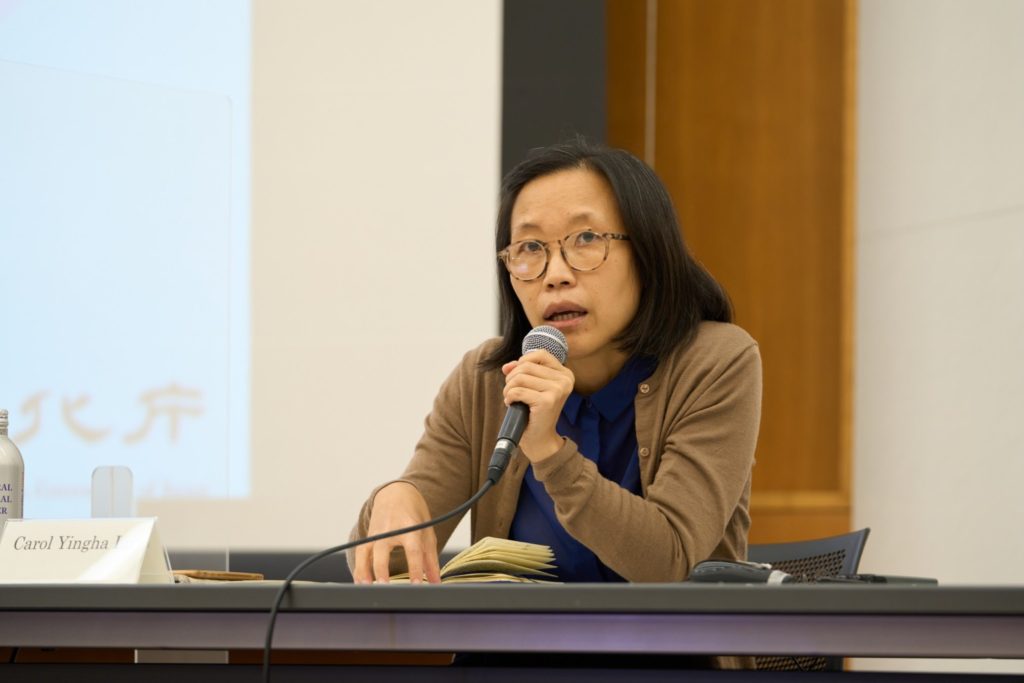
“International Exchanges That Prioritize Specific Experiences”
Carol Yinghua Lu (Art historian and curator / Artistic director, Yokohama Triennale 2023 / Director, Inside-Out Art Museum, Beijing)
Carol Yinghua Lu will serve as artistic director of the Yokohama Triennale 2023 with artist Liu Ding.
First, Lu introduced “Discordant Harmony,” a multi-year exhibition she organized with workshop moderator Kamiya and two curators from South Korea and Taiwan. The exhibition toured Seoul, Hiroshima, Taipei, and Beijing, expanding dialogue among Asian countries while consistently asking the question, “What is Asian-ness?”
“It made me realize how little we Asians as neighbors know about each other,” said Lu. “We have always referred to the West, but that was a received perspective, not a constructed one.”
Each exhibition had a different theme and lineup of featured artists in each touring location. The Beijing exhibition, which Lu curated, was a window into “a consideration of subjectivity and historical and intellectual perspectives” covering the late 1980s and early 1990s, and featured a talk by a Japanese professor.
Like many other Asian countries, China rode a wave of economic growth in the 1990s, but behind that growth were certain special conditions.
Lu noted that “many Chinese artists were celebrated in the developed democracies as symbols of defiance against the state, but a closer look reveals that many of them were following the national ideology of their time.” She cited her 2017 article published on e-flux on the internationalization and simultaneous de-internationalization of Chinese artists. “Their embrace of Western culture was in line with steps taken to establish the Party’s leadership in the cultural and intellectual sphere.”
Lu said that knowing history is an important backbone in the construction of “Asia.” Biennials are a product of globalization, and it has become common for curators of international exhibitions to gravitate toward cultural studies. History is lost in the conversation, “intensified by postmodernism and its denial of genealogy,” she noted, pointing out that “workshops such as this one are a good opportunity for critical reflection.”
Discussion
In a world where various gender, racial, national-border-based, and other divisions have manifested after the onset of the pandemic, can art be a medium that generates deep dialogue? The discussion in this session, with speakers and participants from previous sessions also taking part, focused on the overarching theme of art’s contribution to society.
Darmawan said that the question of what art can do for society has been asked repeatedly for decades, and that he would like to focus on practices that break down the current “art system” that has separated the everyday from art. Lu said that all the divisions, institutions, and conceptual problems we are facing were created in the 20th century, and that it is important to rethink history in order to rebuild new systems. Responding to Pi Li’s idea of “sharing space-time,” Reuben Keehan of the Queensland Art Gallery, Gallery of Modern Art in Brisbane pointed out the importance of dialogue with the younger generation of artists who shared the universal experience of the pandemic. Barto, a member of ruangrupa and currently at the Yamaguchi Center for Arts and Media, also spoke of the importance of having not just a single one but repeated conversations with others, including artists and local people.
Darmawan said that Documenta 15 was a clash between the two systems of lumbung and Documenta. He described the many attempts to reform the segmented principles of Documenta, and asserted that despite the fact that these efforts caused a lot of friction, he believes he was able to demonstrate that there is an alternative way of doing things.Kamiya concluded the session by reaffirming the importance of practice, saying that he hopes that participants will bring back to their respective institutions lessons learned from the challenges that ruangrupa took on at Documenta.
The third and final day of the workshop featured a wrap-up session by the participants and a visit to the Aichi Triennale 2022, bringing the 2022 workshop to a close.
The Bunka-cho Contemporary Art project, which has worked to promote contemporary Japanese art and to raise its international profile since fiscal 2018, will complete its five-year term as a project commissioned by the Agency for Cultural Affairs at the end of this fiscal year, moving into a new phase after that. This workshop summarized the past five years while serving as a bridge to the next phase of the project. It was reassuring to realize that shared histories and perspectives are changing in today’s complex and ever more diverse international society, and that the networking that began in Asia in the 1990s is growing into actual solidarity in the 2020s. As we move toward the end of the first quarter of the 21st century, it is my hope that Japan’s cultural policies for the promotion of contemporary art will encourage a move away from the “Japan is great” perspective of simply seeking to improve the country’s position, becoming rooted instead in common ground reflecting our membership in the international community, and providing backup for ground-level practices that bring the population up to that same level of understanding.
Translated by Ilmari Saarinen
INFORMATION
4th Bunka-cho Contemporary Art Workshop
Date: 2022.9. 23 – 24 (Day 2)
Venue: Zoom Webinar (Aichi Arts Center)
Organizer: Bunka-cho
Photo: Sengoku Ken(.new)


